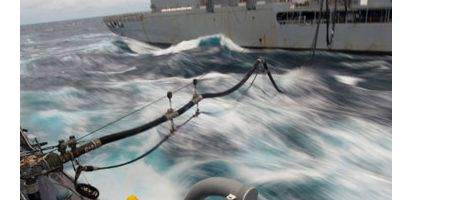Scientists at the US Naval Research Laboratory are developing a process to extract carbon dioxide from seawater and use it to produce hydrogen gas, which can then be catalytically converted into jet fuel.

They’ve successfully recovered CO2 and produced hydrogen using an electrochemical acidification cell, and converted it to hydrocarbons that can be used to produce the fuel.
“The potential payoff is the ability to produce JP-5 fuel stock at sea, reducing the logistics tail on fuel delivery with no environmental burden and increasing the Navy’s energy security and independence,” says research chemist Dr Heather Willauer.
“With such a process, the Navy could avoid the uncertainties inherent in procuring fuel from foreign sources and/or maintaining long supply lines.”
NRL has developed a two-step process in the laboratory to convert the CO2 and H2 gathered from the seawater to liquid hydrocarbons. In the first step, an iron-based catalyst has been developed that can achieve CO2 conversion levels up to 60 percent. It also decreases unwanted methane production from 97 percent to 25 percent, instead producing longer-chain unsaturated hydrocarbons (olefins).
In the second step, these olefins can be oligomerized – a chemical process that converts molecules of low molecular weight to a compound of higher molecular weight – into a liquid containing hydrocarbon molecules in the carbon C9-C16 range. This can then be converted to jet fuel through a nickel-supported catalyst reaction.
The technique has been tested using seawater from the Gulf of Mexico to simulate conditions that will be encountered in an actual open ocean process. NRL is working to optimize the process and scale it up – but says that initial studies predict a cost of $3 to $6 for fuel produced this way.






